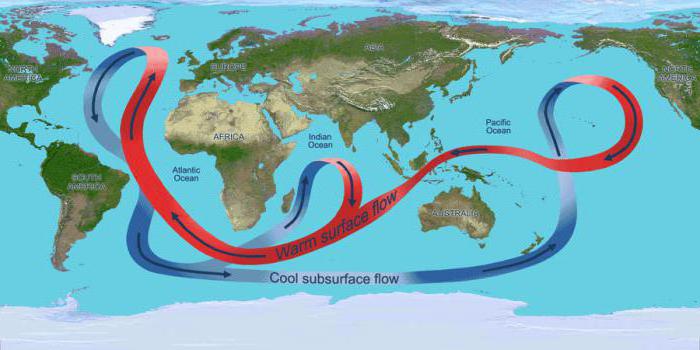The oceans are one of the most mysterious phenomena. Even at present it is not fully understood. What makes it unique? First of all, these are ocean currents. They play a large role in shaping the climate on planet Earth, and are also largely responsible for the diversity of flora and fauna. Today we will get acquainted with the types of currents, the cause of their occurrence, and consider examples.
It's no secret that our planet is washed by four oceans: the Pacific, Atlantic, Indian and Arctic. Naturally, the water in them cannot be stagnant, as this would long ago have led to an environmental disaster. Due to the fact that it is constantly circulating, we can fully live on Earth. Below is a map of ocean currents, it clearly shows all the movements of water flows.
What is an ocean current?
The course of the oceans is nothing more than the continuous or periodic movement of large masses of water. Looking ahead, we’ll immediately say that there are many of them. They differ in temperature, direction, depth, and other criteria. Ocean currents are often compared to rivers. But the movement of river flows occurs only downward under the influence of gravitational forces. But the circulation of water in the ocean occurs due to many different reasons. For example, wind, uneven density of water masses, temperature difference, the influence of the moon and the sun, changes in pressure in the atmosphere.
Causes of occurrence
I want to start my story with the reasons that give rise to the natural circulation of water. There is practically no exact information even now. This is explained quite simply: the system of oceans has no clear boundaries and is in constant motion. Currents that are closer to the surface are now more thoroughly studied. Today, one thing is certain for sure that the factors affecting the circulation of water can be either chemical or physical.

So, we consider the main causes of the occurrence of ocean currents. The first thing I want to highlight is the effect of air masses, that is, wind. It is thanks to him that surface and shallow currents function. Of course, the wind has nothing to do with water circulation at great depths. The second factor is also important, this is the effect of outer space. In this case, the currents arise due to the rotation of the planet. And finally, the third main factor that explains the causes of ocean currents is the different density of water. All streams of the oceans differ in temperature, salinity and other indicators.
Directivity factor
Depending on the direction, the flows of ocean water circulation are divided into zonal and meridional. The former move west or east. Meridional currents go south and north.
There are also other species that are caused by ebbs and flows. Such ocean currents are called tidal. They have the greatest force in shallow water in the coastal zone, in river mouths.
Currents that do not change forces and directions are called stable, or established. These include such as the Northern trade winds and the South trade winds. If the movement of a water stream changes from time to time, then it is called unstable, or unstable. This group is represented by surface currents.
Surface currents
The most noticeable of all are surface currents, which are formed due to the influence of wind. Under the influence of the trade winds, constantly blowing in the tropics, huge flows of water are formed in the equator area. They form the Northern and Southern equatorial (trade winds) currents. A small part of these water masses reverses and forms a counterflow. The main streams deviate north or south in a collision with the continents.
Warm and cold currents
Types of ocean currents play a crucial role in the distribution of climatic zones on Earth. It is customary to call warm the flows of the water area, which carry water with a temperature above zero. Their movement is characterized by a direction from the equator to high geographical latitudes. This current is Alaskan, Gulf Stream, Kuroshio, El Nino, etc.
Cold streams carry water in the opposite direction compared to warm streams. Where a flow with a positive temperature occurs on their way, an upward movement of water occurs. The largest are considered California, Peruvian and others.
The division of currents into warm and cold is conditional. These definitions reflect the ratio of the temperature of the water in the surface layers to the ambient temperature. For example, if the flow is colder than the rest of the water mass, then this flow can be called cold. If on the contrary, then this is considered a warm current.
Ocean currents largely determine climate change on our planet. Constantly mixing water in the oceans, they create conditions favorable for the life of its inhabitants. And our lives directly depend on this.